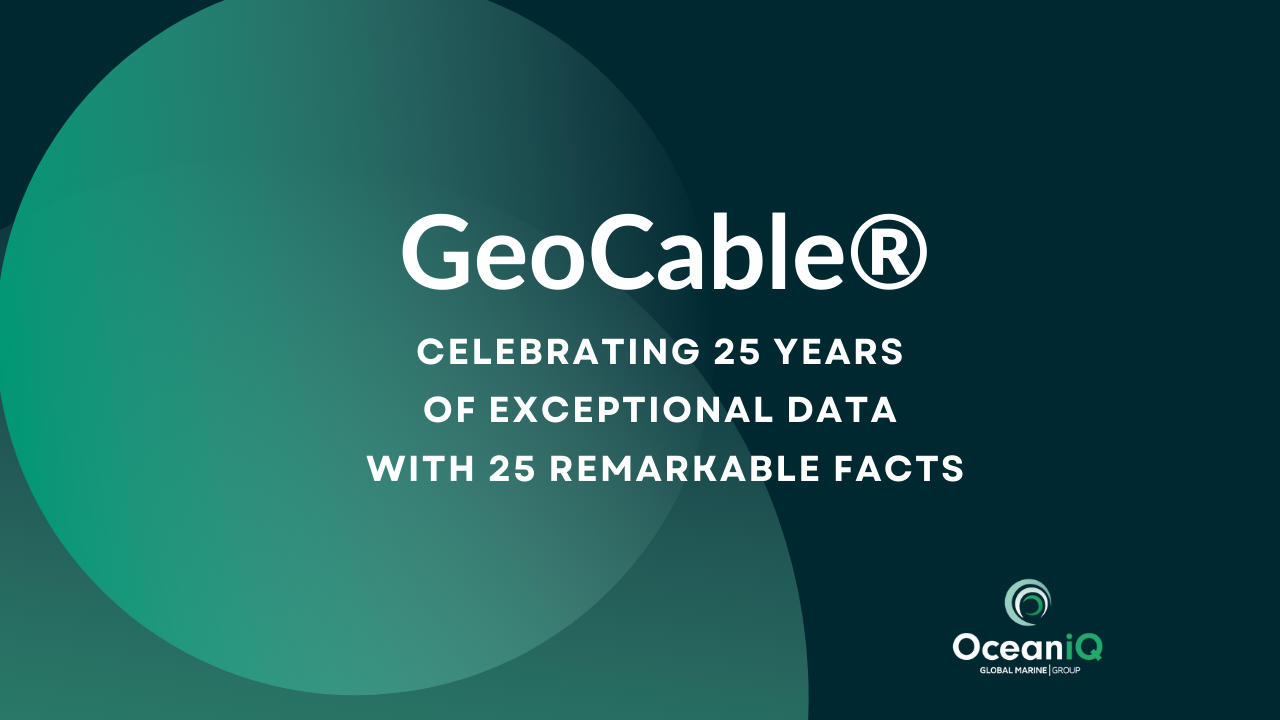The Global Marine Group is pleased to announce the new ownership of the business by Keppel Infrastructure Fund, a fund managed by Keppel.
Contact Us

For a quarter-century, GeoCable® has led the way in mapping, monitoring, and logging subsea cable installation and faults. Leveraging both current and historical data, GeoCable® assists operators in planning new cable installations, facilitating repair operations, predicting potential issues, and enhancing the overall reliability of subsea cable systems.
This invaluable resource is essential for stakeholders in range of marine industries, including renewable energy, power, telecommunications, and surveying.
In the past 25 years, we’ve witnessed a remarkable transformation in subsea fibre optic cables. The proliferation of cables on the ocean floor has significantly increased to accommodate escalating bandwidth demands. New cable deployments have interconnected continents and regions, bolstering communication and data transfer capabilities.
Notably, traditional transatlantic and transpacific routes have seen the addition of new cable systems, along with previously underserved or unconnected areas, heightening global network redundancy and resilience.
In celebration of GeoCable’s 25th anniversary, we’re excited to share some of the interesting statistics that we’ve recorded over the last 25 years.

1. OceanIQ manages a wealth of detailed submarine cable data, spanning well over 170 years of information. The earliest cable in our GeoCable® database dates to 1851. This was the first commercial cable ever installed and ran from England to France.
2. The database contains approximately 97% of the world’s in service and out of service cable systems.
3. There are over 850 in service cable systems comprised of over 2500 individual segments included in the database.
4. Our data provides detailed insights into over 2.8 million kilometres of subsea telecommunications cable.
5. GeoCable® contains data on enough cable to circle the equator 71 times.
6. And enough cable to stretch to the moon 7.4 times.
7. In December 2021 Power GIS layer and Cable Heat Maps became available to customers.
8. 40,000 kilometres of power cable routes are held in our database, enough to circle the equator.
9. There have been 4,101 cable repairs in the last 25 years.
10. Over 5000 historical cable faults were used in the creation of our cable fault Heat Maps.
11. 2022 OiQ launched GeoCable® Light and GeoCable® Pro services.
12. Approximately 80% of routes are plotted using as-laid coordinates. Where we don’t have as laid coordinates, we utilise other sources such as vessel positions and cable awareness data.
13. Our team constantly update the databases and issue regular updates to subscribed members. On average there are 50 updates to the GeoCable® database per month.

14. The GeoCable® database as well as having commercial cables also features many cables used for scientific purposes.
Examples:
15. The database also features some cables used specifically for monitoring the Comprehensive Nuclear-Test-Ban Treaty.
(How is sound used to monitor nuclear testing? – Discovery of Sound in the Sea (dosits.org)
Station Profiles | CTBTO)

16. Approximately 250,000km of submarine telecommunications cable is buried into the seabed.
17. PTAT-1 was the first privately financed transatlantic fibre optic telecommunications cable, which was completed in 1989, at a cost of US$400 million. Covering a distance of 7,552 kilometres (4,693 miles; 4,078 nautical miles). The significance of PTAT-1 is that it broke the international telecommunication monopoly held by AT&T Corporation and British Telecom (BT) for telecommunications between the US and UK. The UK to US section of the cable was shut down on the 8th of February 2004, as it was no longer considered financially viable by Cable & Wireless.
18. A significant portion of PTAT-1 has been repurposed and redeployed for the US-Bermuda system. Underscoring the importance of recording the process of cable recovery in our database management.
19. Approximately 9.3% (105,000km) of out of service cable has been recovered for recycling or repurposing as new systems.
20. 95% of countries with a shoreline have at least one cable landing.
21. Currently, the USA boasts over 80 operational cable landings, holding the highest number globally.
22. There have been a total of 60 cables that have crossed the North Atlantic. 21 of which are still in service.
23. There have been 28 cables crossing the North Pacific. 20 of which are still in service.
24. The deepest submarine cable goes down to approximately 9700m water depth.
25. The only continent currently not connected by cable is Antarctica.
GeoCable® boasts an unmatched compilation of subsea cable data meticulously curated and continually refreshed over many years. Responding to increasing interest from diverse business sectors beyond conventional GIS teams, we have expanded the scope of GeoCable® offerings. Our enhanced GeoCable® dataset is conveniently accessible through our complimentary submarine cable map or via subscription services like GeoCable®Light and GeoCable®Pro, tailored to accommodate varying user requirements. For further details on these product options, please click here.

| Cookie | Duration | Description |
|---|---|---|
| bcookie | 2 years | LinkedIn sets this cookie from LinkedIn share buttons and ad tags to recognize browser ID. |
| lang | session | This cookie is used to store the language preferences of a user to serve up content in that stored language the next time user visit the website. |
| lidc | 1 day | LinkedIn sets the lidc cookie to facilitate data center selection. |
| __atuvc | 1 year 1 month | AddThis sets this cookie to ensure that the updated count is seen when one shares a page and returns to it, before the share count cache is updated. |
| __atuvs | 30 minutes | AddThis sets this cookie to ensure that the updated count is seen when one shares a page and returns to it, before the share count cache is updated. |
| __cf_bm | 30 minutes | This cookie, set by Cloudflare, is used to support Cloudflare Bot Management. |
| __hssc | 30 minutes | HubSpot sets this cookie to keep track of sessions and to determine if HubSpot should increment the session number and timestamps in the __hstc cookie. |
| Cookie | Duration | Description |
|---|---|---|
| hubspotutk | 1 year 24 days | This cookie is used by HubSpot to keep track of the visitors to the website. This cookie is passed to Hubspot on form submission and used when deduplicating contacts. |
| uvc | 1 year 1 month | Set by addthis.com to determine the usage of addthis.com service. |
| vuid | 2 years | Vimeo installs this cookie to collect tracking information by setting a unique ID to embed videos to the website. |
| _ga | 2 years | The _ga cookie, installed by Google Analytics, calculates visitor, session and campaign data and also keeps track of site usage for the site's analytics report. The cookie stores information anonymously and assigns a randomly generated number to recognize unique visitors. |
| _gat_UA-178530081-1 | 1 minute | A variation of the _gat cookie set by Google Analytics and Google Tag Manager to allow website owners to track visitor behaviour and measure site performance. The pattern element in the name contains the unique identity number of the account or website it relates to. |
| _gid | 1 day | Installed by Google Analytics, _gid cookie stores information on how visitors use a website, while also creating an analytics report of the website's performance. Some of the data that are collected include the number of visitors, their source, and the pages they visit anonymously. |
| __hstc | 1 year 24 days | This is the main cookie set by Hubspot, for tracking visitors. It contains the domain, initial timestamp (first visit), last timestamp (last visit), current timestamp (this visit), and session number (increments for each subsequent session). |
| Cookie | Duration | Description |
|---|---|---|
| bscookie | 2 years | This cookie is a browser ID cookie set by Linked share Buttons and ad tags. |
| loc | 1 year 1 month | AddThis sets this geolocation cookie to help understand the location of users who share the information. |
| Cookie | Duration | Description |
|---|---|---|
| AnalyticsSyncHistory | 1 month | No description |
| at-rand | never | No description available. |
| ep201 | 30 minutes | This cookie is set by the provider Surveymonkey. This cookie is used for statistical analysis and website optmization. It gathers information on user's interaction with the SurveyMonkey- Widget on thewebsite. |
| ep203 | 3 months | No description available. |
| li_gc | 2 years | No description |
| m | 2 years | No description available. |
| paywallredirect | 1 day | No description |
| UserMatchHistory | 1 month | Linkedin - Used to track visitors on multiple websites, in order to present relevant advertisement based on the visitor's preferences. |